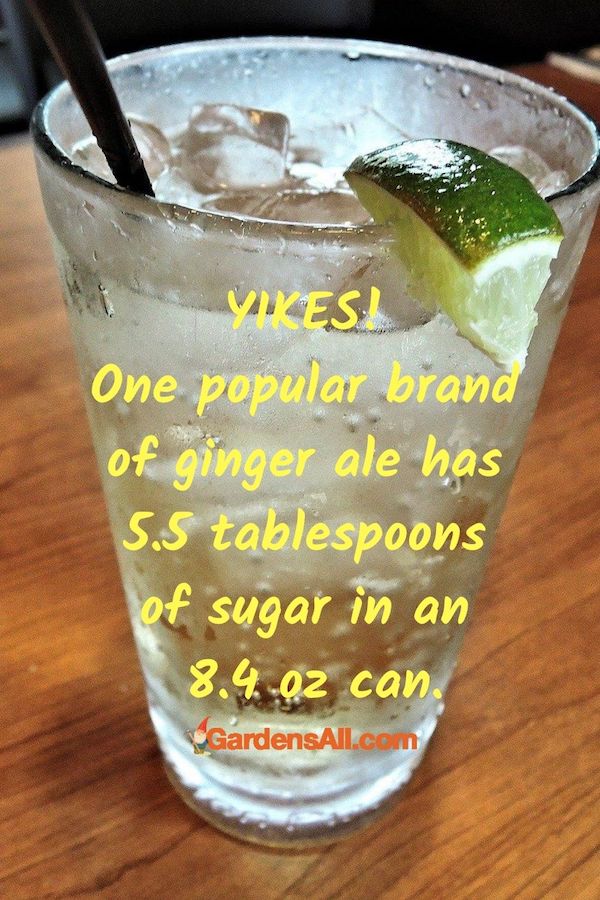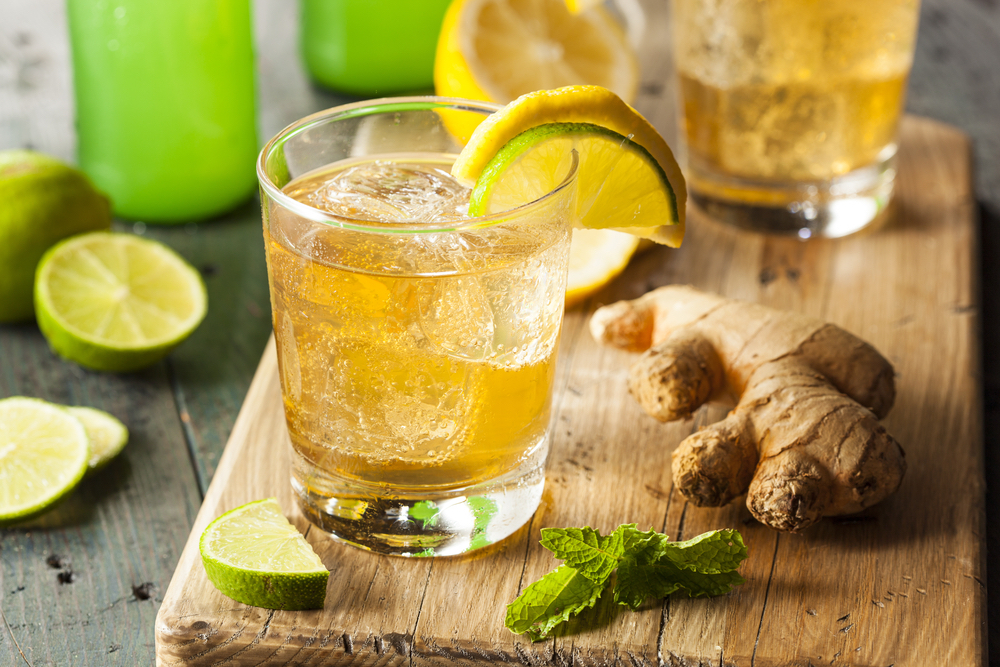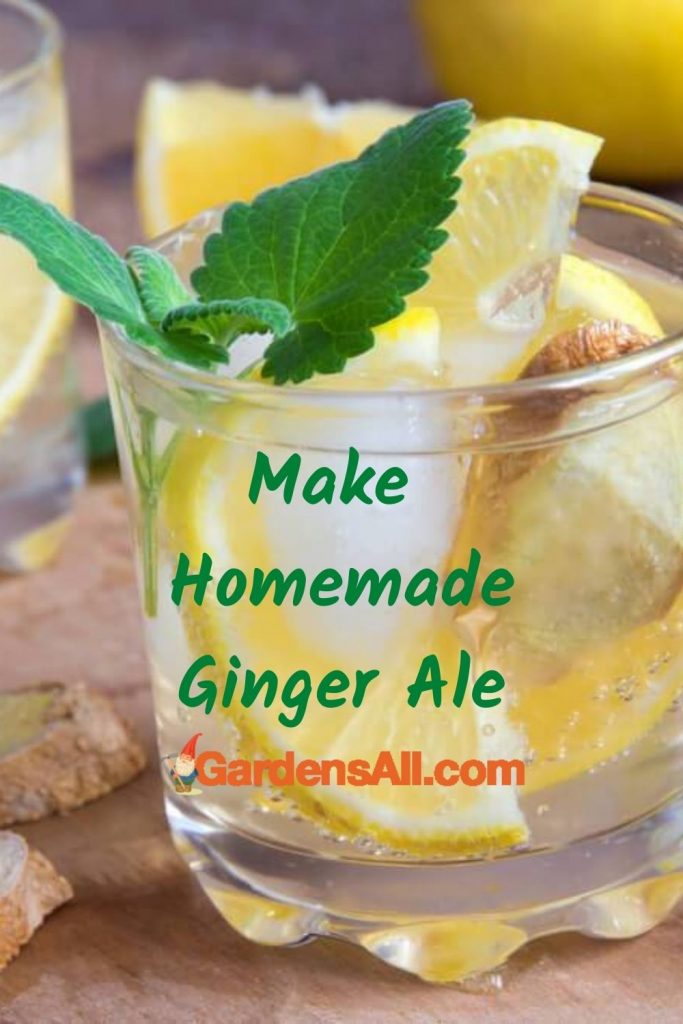The Real Ginger Ale
Homemade ginger ale can be such a refreshing—and healthy—beverage, especially if you make your own using fresh ginger root. It tastes much better and more real than most on the market today. Beyond that, homemade ginger ale provides some of the health benefits of ginger root.
If you’re growing your own ginger, all the better. It’s easy to grow in pots indoors and out. You may be interested in our article on white butterfly ginger.
Store Bought Ginger Ale Can’t Compare
If you look at a bottle of the typical store-bought ginger ale you will see that ginger is often not listed. Investigation reveals the ginger in Canada Dry Ginger Ale is lumped under ‘Natural Flavorings”.
Of course Canada Dry isn’t marketing it’s beverage as beneficial for your health. But some folks go for ginger ale because they know that ginger is good for you.
If Canada Dry Ginger Ale did have enough ginger in it for therapeutic health benefits, it may be rendered unhealthy due to all the sugars and other detrimental ingredients. Worse, it often has high fructose corn syrup (HFCS) in it, which is proven to cause disease and obesity.
A 12 oz can of the average ginger ale contains 9 teaspoons of sugar!! That’s three tablespoons of sugar in just 12 ounces of soda![1]https://www.livestrong.com/article/118910-negative-health-side-effects-canada/[2]https://www.ncbi.nlm.nih.gov/pmc/articles/PMC3522469/[3]https://www.princeton.edu/main/news/archive/S26/91/22K07/
This Canada Dry Ginger Ale contains high fructose corn syrup and 8.75 teaspoons of sugar in a 12 oz serving. That’s almost 3 Tablespoons per can.

A 12 oz can of a popular brand of ginger ale contains 8.75 teaspoons of sugar!
Organic Label – But Not Healthy
And, this organic version: Blue Sky Organic Ginger Ale contains organic cane sugar, and the ginger is listed under flavorings. But this ginger ale contains over 9 teaspoons of sugar (almost 10 teaspoons!!) at 39 grams per 12 oz serving.

Maybe the Worst Store Bought Ginger Ale
This Organics Red Bull has mostly organic ingredients and plant flavoring, including ginger. This 8.4 oz can contains 22 teaspoons of sugar. That’s over 7 Tablespoons!! WHAT?!? Even Grandma wouldn’t stand there and dollop 5.5 tablespoons of sugar into her 8.4 ounce sweet tea!!

No one needs that blow to their health. All the more reason to make your own.
When you make your own ginger ale, keep in mind that it can take some time for your taste buds to become more sensitive to fresher, subtler flavors after being bombarded with loads of sugar, salt and flavor additives in everything. So test and tweak the recipe until it suits you just right. Then, sit back and enjoy this treat, knowing it’s tasty and healthy too!
YIKES! One popular brand of ginger ale has 5.5 tablespoons of sugar in an 8.4 oz can.

Homemade Ginger Ale Recipe
Ingredients:
- 2 cups filtered water, or naturally sparkling mineral water
- 1 tsp. organic dark maple syrup (the darker, the more mineral dense)
- 3 inches ginger root, grated or juiced
- 1 lemon, juiced
- 4 leaves lemon balm (alternatively, basil or holy basil)
- Pinch cayenne – Optional
Method:
1. Juice your ginger root with a juicer, or, grate it finely in a mini food processor or zester.
2. Combine ginger juice (or grated ginger)*, maple syrup, lemon, cayenne pepper and herbs in a large jar or bottle. We use our Soda Stream bottles. Shake well.
3. Add about half a cup of the sparkling water and roll bottle gently to stir.
4. Add the remaining carbonated water right before serving. Roll the bottle or gently turning it upside down and over a few times.
5. Drink immediately or make ahead and refrigerate overnight to let the flavors steep more fully.
Note 1: If grating ginger, we recommend letting it steep in the liquid concoction for around 30 minutes before consuming. If you like it strong, leave the ginger in the liquid and strain it as you serve it. If you like it less strong, then strain it after 15-30 minutes for drinking. Consider if you can add the discarded ginger and lemon and basil pulp to a vegetable stir fry.
Note 2: We make our own carbonated water using a Soda Stream and our filtered well water, which is less expensive than buying sparkling mineral water. Or for a non-fizzy drink, just use water.
Note 3: If you prefer fermented ginger ale, see contributions from the community at the end of this page.
Substitutions and Variations
SWEETENERS: Stevia leaves, liquid or powder
HERBS: any mints, basil, tulsi (holy basil)
FLOWERS: Dandelion, nasturtiums, violets, roses, ec.
LIQUIDS: Add herbal iced teas for a more punch like brew
Photo via Flickr Vanessa[4]https://www.flickr.com/photos/niftythriftythings/
There are many healthy benefits to ginger, which we touch on next.

Ginger Health Benefits
- Anti blood clotting
- Antibacterial
- Anti-cancer potential
- Anti-inflammatory
- Antioxidative
- Arthritic pain and swelling
- Bloating and constipation
- Boosts immunity
- Detoxifies
- Immunonutrition (nutrient induced or improved immunity)
- Indigestion
- Muscle pain
- Nausea
SOURCES – STUDIES:
Anti-Oxidative and Anti-Inflammatory Effects of Ginger in Health and Physical Activity.
Herbal Medicine: Biomolecular and Clinical Aspects – The Amazing Ginger, chptr 7.
Remember to visit our article on white butterfly ginger for more on growing edible ginger.
Ginger is an important ingredient in cold care remedies as well as the favorite fire cider tonic. Let us know your favorite ginger ale recipe and/or health benefits and uses of ginger.
Contributions from the Community
Fermented Ginger Ale
I’ve been making ginger ale for years, using David Fankhauser’s method, with one exception. He uses baker’s yeast and I prefer champagne yeast for a less yeasty flavor.
Using sparkling water is one way to make ginger ale without the wait for fermentation. But I personally like the taste of the fermented recipe better. The sugar is mostly consumed by the yeast, and the resulting product is not overly sweet.
~Liz Wallis, contributing writer on Turmeric Golden Paste

Wishing you great gardens and health!
We are an online gardening publication sharing all things garden related! Including urban farming, family gardening, homesteading, gardening for profits, and more. We’re all about growth!
References

